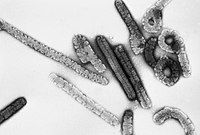
Photo from wikipedia
Endemic regions for Puumala virus (PUUV) are located in the most affected federal state Baden‐Wuerttemberg, South‐West Germany, where high numbers of notified human hantavirus disease cases have been occurring for… Click to show full abstract
Endemic regions for Puumala virus (PUUV) are located in the most affected federal state Baden‐Wuerttemberg, South‐West Germany, where high numbers of notified human hantavirus disease cases have been occurring for a long time. The distribution of human cases in Baden‐Wuerttemberg is, however, heterogeneous, with a high number of cases recorded during 2012 in four districts (H districts) but a low number or even no cases recorded in four other districts (L districts). Bank vole monitoring during 2012, following a beech (Fagus sylvatica) mast year, resulted in the trapping of 499 bank voles, the host of PUUV. Analyses indicated PUUV prevalences of 7–50% (serological) and 1.8–27.5% (molecular) in seven of eight districts, but an absence of PUUV in one L district. The PUUV prevalence differed significantly between bank voles in H and L districts. In the following year 2013, 161 bank voles were trapped, with reduced bank vole abundance in almost all investigated districts except one. In 2013, no PUUV infections were detected in voles from seven of eight districts. In conclusion, the linear modelling approach indicated that the heterogeneous distribution of human PUUV cases in South‐West Germany was caused by different factors including the abundance of PUUV RNA‐positive bank voles, as well as by the interaction of beech mast and the proportional coverage of beech and oak (Quercus spec.) forest per district. These results can aid developing local public health risk management measures and early warning models.
Journal Title: Zoonoses and Public Health
Year Published: 2017
Link to full text (if available)
Share on Social Media: Sign Up to like & get
recommendations!